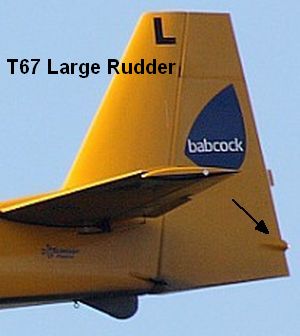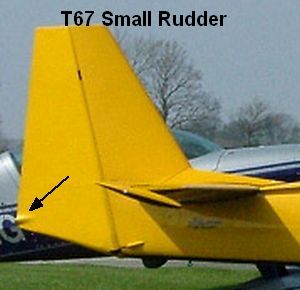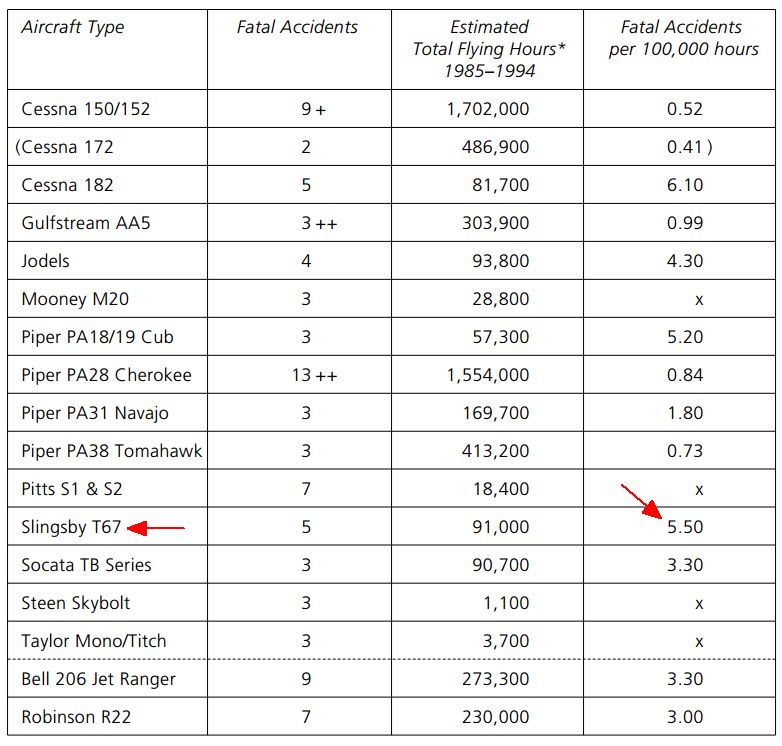Slingsby Firefly's
Join Date: Sep 2002
Location: New Jersey
Posts: 858
Likes: 0
Received 0 Likes
on
0 Posts
All three of the instructors that died in the T-3A made it through the T-37 twin jet, the supersonic T-38, C-141 FO training, C-141 captain training, C-141 aerial refueling training and yet the T-3A killed them. Maybe if the T-3A required such a high training standard it shouldn't have been used for initial flight training.
greene, you didn't fly the T-3A. It's very different from what you flew.
The T-3A flew perfectly fine until it didn't. The T67 has a worldwide history of occasionally not recovering from spins.
When you look at how many aircraft were destroyed and how many people died in the T67 and T-3A there's not much argument left.
greene, you didn't fly the T-3A. It's very different from what you flew.
The T-3A flew perfectly fine until it didn't. The T67 has a worldwide history of occasionally not recovering from spins.
When you look at how many aircraft were destroyed and how many people died in the T67 and T-3A there's not much argument left.
Join Date: Sep 2002
Location: New Jersey
Posts: 858
Likes: 0
Received 0 Likes
on
0 Posts
T-3A Weight and Balance
An aircraft becomes less stable as the center of gravity shifts rearward. A more rearward CG can also make an aircraft more likely to stay in a stabilized spin and make recovery more difficult. Move the CG far enough aft and it may become impossible to get an aircraft out of a spin. A Few months after the first accident I began inquiring about weight and balance information on the T-3. Because the entire fleet was new, none of the T-3's had been measured (put on scales) since they left the factory. I asked our maintainers about the weight and balance measurement procedure but no one knew how to level the plane for the measurement. I knew the aircraft's measurement datum line and how to calculate the moments but I needed to know how to level the plane for an accurate measurement. Typically the procedure is to place a level on the cockpit or storage compartment floor. I contacted Hondo's maintenance chief and he said he didn't know how to do it since the procedure hadn't been needed yet. I even contacted Slingsby but could not get an answer. I got the feeling they didn't want us to look into the CG issue too carefully.
I decided to weigh the aircraft anyway. I put a T-3 on the scales with full wing tanks and oil plus me and a cadet with our parachutes on in the seats with the canopy closed--exactly the situation for a normal takeoff. The aircraft was scaled inside a hangar with a known level floor. The weights at all three wheels were taken and the numbers crunched. We were over two inches rear of the rear CG limit! I tried to push this info up the chain of command but because the aircraft wasn't leveled to Slingsby's specification (whatever that was) no one believed the numbers. I know that leveling the aircraft will move the CG but there's no way that was going to shift the CG two inches forward--you'd have to stand the aircraft on it's freakin' nose to do that. The bottom line is we were flying the aircraft with an extremely aft center of gravity and no one wanted to admit it.
One other note about T-3A spins, the aircraft would not recover from a spin if you released the controls, it would actually wrap up and spin faster with the nose lower.
An aircraft becomes less stable as the center of gravity shifts rearward. A more rearward CG can also make an aircraft more likely to stay in a stabilized spin and make recovery more difficult. Move the CG far enough aft and it may become impossible to get an aircraft out of a spin. A Few months after the first accident I began inquiring about weight and balance information on the T-3. Because the entire fleet was new, none of the T-3's had been measured (put on scales) since they left the factory. I asked our maintainers about the weight and balance measurement procedure but no one knew how to level the plane for the measurement. I knew the aircraft's measurement datum line and how to calculate the moments but I needed to know how to level the plane for an accurate measurement. Typically the procedure is to place a level on the cockpit or storage compartment floor. I contacted Hondo's maintenance chief and he said he didn't know how to do it since the procedure hadn't been needed yet. I even contacted Slingsby but could not get an answer. I got the feeling they didn't want us to look into the CG issue too carefully.
I decided to weigh the aircraft anyway. I put a T-3 on the scales with full wing tanks and oil plus me and a cadet with our parachutes on in the seats with the canopy closed--exactly the situation for a normal takeoff. The aircraft was scaled inside a hangar with a known level floor. The weights at all three wheels were taken and the numbers crunched. We were over two inches rear of the rear CG limit! I tried to push this info up the chain of command but because the aircraft wasn't leveled to Slingsby's specification (whatever that was) no one believed the numbers. I know that leveling the aircraft will move the CG but there's no way that was going to shift the CG two inches forward--you'd have to stand the aircraft on it's freakin' nose to do that. The bottom line is we were flying the aircraft with an extremely aft center of gravity and no one wanted to admit it.
One other note about T-3A spins, the aircraft would not recover from a spin if you released the controls, it would actually wrap up and spin faster with the nose lower.
Robrob,
I believe that the USAF Flight Test Centre at Edwards flew an extensive spin trial after the accidents and did not identify any particular problems with spin recovery. Do you have any details on this trial?
I have heard stories that the early T67s would not recover after 'reverse control recovery' inputs i.e. stick forward before before applying opposite rudder. The recovery from this situation was to re-apply full pro-spin controls and then perform a normal recovery although this invoked a large height loss. I believe that later T67s did not suffer from this problem. Does anyone have any more details of this?
I believe that the USAF Flight Test Centre at Edwards flew an extensive spin trial after the accidents and did not identify any particular problems with spin recovery. Do you have any details on this trial?
I have heard stories that the early T67s would not recover after 'reverse control recovery' inputs i.e. stick forward before before applying opposite rudder. The recovery from this situation was to re-apply full pro-spin controls and then perform a normal recovery although this invoked a large height loss. I believe that later T67s did not suffer from this problem. Does anyone have any more details of this?
Join Date: Sep 2008
Location: West Sussex
Posts: 319
Likes: 0
Received 0 Likes
on
0 Posts
.........I have heard stories that the early T67s would not recover after 'reverse control recovery' inputs i.e. stick forward before before applying opposite rudder. The recovery from this situation was to re-apply full pro-spin controls and then perform a normal recovery although this invoked a large height loss. I believe that later T67s did not suffer from this problem. Does anyone have any more details of this?
I have never experienced this type of spin, but I have done many conventional spin recoveries in the Slingsby with no problems at all.
I understand that there have been some issues when aircraft have been carelessly towed by vehicles causing the pedal mechanism to distort and foul the airframe. I seem to recall some ADs were issued to inspect the pedals and reinforce the floor pan.
Join Date: Sep 2008
Location: West Sussex
Posts: 319
Likes: 0
Received 0 Likes
on
0 Posts
........... The recovery from this situation was to re-apply full pro-spin controls and then perform a normal recovery although this invoked a large height loss.....
This will obviously use a lot of height, which is the main reason I have not tried to induce the high rotation rate spin myself.
dobbin1,
Many thanks. My interest in this is that I was involved in discussions many moons ago about potential UK military registration of the Barkston aircraft and the need to re-apply full back stick following a mishandled recovery was not what would normally be acceptable for military clearance.
Rgds
L
Many thanks. My interest in this is that I was involved in discussions many moons ago about potential UK military registration of the Barkston aircraft and the need to re-apply full back stick following a mishandled recovery was not what would normally be acceptable for military clearance.
Rgds
L
Join Date: Sep 2002
Location: New Jersey
Posts: 858
Likes: 0
Received 0 Likes
on
0 Posts
There was another Slingsby T67 fatal spin-to-the-ground accident in the UK in April 2016.
Anyone that thinks the Slingsby T67/T-3A Firefly is a safe airplane needs to read these accident reports: https://aviation-safety.net/wikibase...php?AcType=RF6
280 aircraft built and at least 30 hull losses and 35 fatalities. Many of them are spin related. I call it the "Plastic Coffin."
From a UK Fatal Stall or Spin Accident summary (1980-2008) report:
Keep in mind that pretty much every one of the dead Firefly pilots thought it was a safe airplane until just before impact so don't tell me, "I fly the T67 and it's a safe airplane." It's not. It's statistics are shockingly bad. It's got to be right up there with the 104 Starfighter.
Anyone that thinks the Slingsby T67/T-3A Firefly is a safe airplane needs to read these accident reports: https://aviation-safety.net/wikibase...php?AcType=RF6
280 aircraft built and at least 30 hull losses and 35 fatalities. Many of them are spin related. I call it the "Plastic Coffin."
From a UK Fatal Stall or Spin Accident summary (1980-2008) report:
The accident rate for the Slingsby T67 was throughout the period much greater than any other certified type and has been treated as a special case.
The Slingsby T67, (8 fatal accidents) was excluded from the main numerical analysis but was studied as a special case. (See Appendix 2 of the full Report).
The Slingsby T67, (8 fatal accidents) was excluded from the main numerical analysis but was studied as a special case. (See Appendix 2 of the full Report).
Keep in mind that pretty much every one of the dead Firefly pilots thought it was a safe airplane until just before impact so don't tell me, "I fly the T67 and it's a safe airplane." It's not. It's statistics are shockingly bad. It's got to be right up there with the 104 Starfighter.
Last edited by robrob; 5th May 2016 at 12:40.
Guest
Posts: n/a
A spitfire takes off and crashes because the pilot took off with coarse pitch set. I suspect this happened a few times. Does that make it a dangerous aircraft or an aircraft with a flaw that needs to be understood by the aircrew? The published spin recovery for Firefly works - it is utterly tragic that 2 pilots have been lost but let's learn from it, master our aircraft and all be better pilots as a result of their loss. Rest in peace fellow aviators.
Join Date: Sep 2002
Location: New Jersey
Posts: 858
Likes: 0
Received 0 Likes
on
0 Posts
Gipsy, you should say, "The published spin recovery for Firefly usually works," because sometimes it doesn't. Read about all the T67 spin accidents--there's a lot of them.
Here is an interesting tidbit about the T67 and T-3A aircraft I just learned. T67's come with a small or large rudder. All the T-3A's came with the small rudder.
T67 with "Big Rudder"

T67 with "Small Rudder"

T-3A with "Small Rudder

Note how bottom edge of the T67 "big rudder" (first photo) follows the angle of the bottom of the empennage and so has about two inches of rudder below the trailing edge position light. The T-3A on the right has a smaller rudder that angles up to the position light.
If we estimate the bottom length of the rudder to be 14 inches that gives us: (14 x 2) / 2 = 14 square inches. Fourteen square inches of additional rudder that's in the best possible location--mostly at the trailing edge below the elevator in clean airs during a spin. If I owned a T67 with the small rudder I'd look into replacing it with the larger rudder.
I noticed the April 2016 spin crash T67 has a small T-3A style rudder.

Here is an interesting tidbit about the T67 and T-3A aircraft I just learned. T67's come with a small or large rudder. All the T-3A's came with the small rudder.
T67 with "Big Rudder"

T67 with "Small Rudder"

T-3A with "Small Rudder

Note how bottom edge of the T67 "big rudder" (first photo) follows the angle of the bottom of the empennage and so has about two inches of rudder below the trailing edge position light. The T-3A on the right has a smaller rudder that angles up to the position light.
If we estimate the bottom length of the rudder to be 14 inches that gives us: (14 x 2) / 2 = 14 square inches. Fourteen square inches of additional rudder that's in the best possible location--mostly at the trailing edge below the elevator in clean airs during a spin. If I owned a T67 with the small rudder I'd look into replacing it with the larger rudder.
I noticed the April 2016 spin crash T67 has a small T-3A style rudder.

Last edited by robrob; 7th May 2016 at 14:58.
Join Date: Jul 2003
Location: uk
Posts: 1,041
Likes: 0
Received 0 Likes
on
0 Posts
Looking at those pics the width of the elevator seems small.
I'm only familiar with PA28, C152 with large elevator and rudder and Tramahawk.
If an aircraft is spinning and then recovery, is one elevator completely blanked off?
Is there enough elevator authority to un-stall the wings.
Perhaps not given that some folks say stick all the way forward.
Bit critical.
Would be interested to know if elevator forces are light on this type.
(Only ever had a go in one at Barkston Heath, what a joke of a day, say no more).
I'm only familiar with PA28, C152 with large elevator and rudder and Tramahawk.
If an aircraft is spinning and then recovery, is one elevator completely blanked off?
Is there enough elevator authority to un-stall the wings.
Perhaps not given that some folks say stick all the way forward.
Bit critical.
Would be interested to know if elevator forces are light on this type.
(Only ever had a go in one at Barkston Heath, what a joke of a day, say no more).
Last edited by BigEndBob; 7th May 2016 at 22:19.





